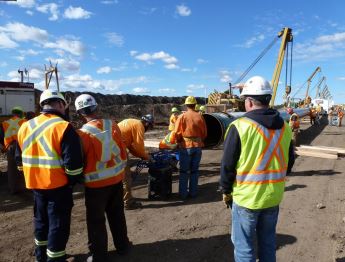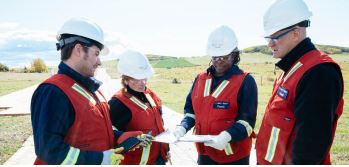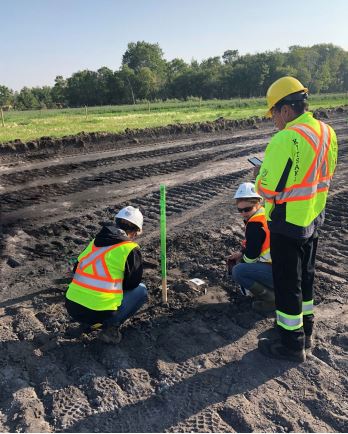Core Responsibilities: What we achieved
Safety and Environment Oversight
The Canada Energy Regulator works for Canadians to keep energy moving safely and efficiently through our country’s pipelines and powerlines. The organization carries out this function by setting and enforcing regulatory expectations for companies over the full lifecycle - construction, operation and abandonment - of energy related activities.
Regulated companies are also required by the CER to anticipate, manage, and mitigate any potential harm to safety and the environment that may occur through the full lifecycle of their energy facilities.
The CER also promotes best practices to reduce the potential for harm and engages with the public, contractors, landowners, and municipalities to promote actions they can take to prevent damage to pipelines.
Our Commitment:
- Harm to people and the environment, through the lifecycle of energy-related infrastructure, is prevented.
Performance Results – Safety and Environment Oversight Results Summary:
| Performance Measure: | Target: | Results 2018-19: | Results 2019-20: |
| Number of incidents related to CER-regulated infrastructure that harm people or the environment. | 0 | 261 | 8 |
| Percentage change of specific incident types on CER-regulated infrastructure. | 10% decrease in incidents | 3% increase | 13% decrease |
| Percentage change of near-misses on CER-regulated infrastructure. | 5% decrease | 22% decrease | 23% increase |
Compliance Activities
Preventing harm is the foundation of how the CER keeps people safe and protects the environment.
The CER aims to achieve zero incidents that harm people or the environment on the 73,000 km of pipeline it regulates. When the activities of regulated companies have the potential to pose greater harm to people or the environment, the CER focuses increased oversight through engagement, inspections, investigations, audits and enforcement, when necessary.

In 2019-20, the CER conducted 295 Compliance Verification Activities (CVAs), which included:
- 114 Inspections
- 20 Emergency Response Exercises
- 7 Management System Audits
- 2 Financial Regulatory Audits
Preventing harm is the foundation of how the CER keeps people safe and protects the environment
The CER also continued its compliance oversight on a number of major pipeline projects in 2019-20.
Trans Mountain Expansion Project (TMX/TMEP)
The Trans Mountain Expansion Project Reconsideration report was issued by the National Energy Board in February 2019. Four months later, the Government of Canada approved the Project. Following the approval, the CER resumed work to ensure the company satisfied all 156 conditions contained within that approval.
Trans Mountain proceeded with construction activities on its TMX pipeline in 2019-20. Throughout each of Trans Mountain’s activities, the CER held the company accountable and verified that it was meeting its requirements and commitments through rigorous compliance verification activities, informed by the CER’s participation in the TMX Indigenous Advisory Monitoring Committee, and in collaboration with Indigenous Monitors.
In 2019-20, the CER undertook over 40 Compliance verification activities covering pipeline integrity, safety, environmental protection, damage prevention, and emergency management. The activities included 24 field inspections, 14 formal compliance meetings and four activities focused on ensuring appropriate emergency preparedness. Twenty-one of those CVAs involved Indigenous Monitors.
Enbridge Line 3 Replacement Project
Construction of the Line 3 replacement project was largely completed during the 2018-19 fiscal year, therefore the CER’s compliance oversight in 2019-20 focused on post-construction reclamation and operational matters. The CER’s regulatory oversight of the new Line 3 and legacy Line 3 in 2019-20 included nine compliance verification activities. Six of these activities were related to safety and environment. Five of these activities were carried out in the field with Indigenous Monitors, and were informed in part through feedback provided by the Line 3 Indigenous Advisory Monitoring Committee.
Keystone XL Pipeline (KXL)
In 2019-20, there was no construction activity on the Keystone XL Project. Although there was no right-of-way construction to inspect in 2019-20, the CER undertook five compliance activities, related to safety, integrity, and environmental protection of the existing Keystone pipeline.
The CER also issued its pre-construction audit of the KXL Project in March 2020. The audit evaluated Keystone’s preparedness to manage construction of the Project in a way that assured worker safety, protection of the environment, and prevention of incidents.
Nova Gas Transmission Ltd.-North Montney (NGTL)

The NGTL North Montney Project involved the construction of 206 km of pipeline in the Peace River Regional District, and related facilities including 2 Compressor Stations and 5 Receipt Meter Stations. Construction on the Aitken Creek section was completed and granted Leave to Open. The system was placed into operation on 31 January 2020. The Kahta section was still under construction at the end of 2019-20, and is expected to be completed and in operation in the first quarter of 2020-21. The remainder of project consists of the construction of two receipt meter stations and final clean-up that will be done in the fall and winter of 2020-21.
Managing Emergencies
CER staff are on call and prepared to respond to an incident in the field 24/7/365. Whenever an emergency occurs at a CER-regulated facility, the organization’s well trained, on-call staff take quick action by overseeing and participating in the field response and by standing up the Emergency Operations Centre.
The focus of the organization’s emergency management work is to ensure that the CER and the companies it regulates are ready to respond to an incident of any size or duration anywhere in the country.
Examples of the CER’s emergency preparedness work in 2019-20 included conducting compliance verification activities and assessing company Emergency Management Programs, delivering business continuity and emergency preparedness planning in response to the COVID-19 Pandemic; and participating in the Canadian Council of Ministers of the Environment Emergency Management Working Group and in Arctic Council Emergency Prevention, Preparedness and Response Working Group initiatives.
Remediation of Contaminated Sites
One of the priorities of the CER’s Safety and Environment Oversight Core Responsibility in 2019-20 was investigating potentially contaminated sites and promoting responsible remediation activities.
The CER achieved an important milestone regarding the remediation of contaminated sites in 2019-20 when it released its draft Remediation Process Guide for stakeholder comment. The Guide is applicable throughout all phases of a project’s lifecycle and it provides clarity on expectations for risk management, criteria selection and engagement; and has new reporting requirements using the CER’s Online Event Reporting System.
Energy Adjudication
The CER regulates and adjudicates upon applications, which include environmental assessments, using processes that are fair, transparent, timely and accessible. These applications pertain to pipelines and related facilities, international power lines, tolls and tariffs, energy exports and imports, oil and gas exploration and drilling in certain northern and offshore areas of Canada as well as future offshore renewable energy projects.
Additionally, the CER regulates Canada’s federal energy infrastructure over its complete lifecycle. During the design and applications assessment phase of projects, it reviews and imposes conditions. Companies must satisfy the CER that they are fulfilling the conditions set in application review, and that they are taking every available action to anticipate, prevent, and mitigate any potential harms associated with their activities. When a project has reached the end of its useful life, the CER reviews abandonment applications to ensure that they are abandoned in a safe and environmentally responsible manner.
The CER Act brought forward changes to the way resource projects are assessed by the Canada Energy Regulator. These changes include early planning and engagement during project reviews, Indigenous engagement and the incorporation of Indigenous knowledge and rights, as well as increased public participation opportunities.
Advancing Canada’s global competiveness is now core to the CER’s mandate. The organization is committed to making decisions in a predictable way and within time limits, providing certainty to investors and stakeholders, driving innovation and enabling the carrying out of sound projects that create jobs for Canadians.
For further details on adjudicative decisions and recommendations to the Governor in Council from the CER, please see the 2019-20 Annual Report of the Commission of the Canada Energy Regulator.
Our Commitment
- Energy adjudication processes are fair, timely, transparent and accessible.
Performance Results-Energy Adjudication Results Summary:
| Performance Measure: | Target: | Results 2018-19: | Results 2019-20: |
| Percentage of adjudication decisions overturned on judicial appeal related to procedural fairness. | 0% | 0% | 0% |
| Percentage of adjudication decisions and recommendations that are made within legislated time limits and service standards. | 100% | 100% | 100% |
| Percentage of surveyed participants who indicate that adjudication processes are transparent. | 75% | 73% | 79% |
| Percentage of surveyed participant funding recipients who agree that participant funding enabled their participation in an adjudication process. | 90% | 100% | 100% |
CER Commission
One of the highlights of the modern governance structure of the Canada Energy Regulator is the establishment of an independent Commission to adjudicate upon energy projects
The Commission is part of the CER and, although its adjudicative role is independent, it contributes to the overall effective delivery of the CER’s mandate and Departmental Results Framework, in particular the CER’s Core Responsibilities of Energy Adjudication and Safety and Environment Oversight.
Improving the CER’s Online Adjudication Information
The CER’s REGDOCS system provides the public with the information they seek in relation to the organization’s adjudication work. It contains over 300,000 documents and receives over 1.3 million page views annually. The system is the most visited page on the CER’s website and has been in need of an upgrade to become a more user-friendly digital platform.
In 2019-20, the CER partnered with Code for Canada, a not-for-profit organization that connects government innovators with the technology and design community, to update REGDOCS.
The upgrades will make the system more navigable and intuitive for the public. It will have an advanced search capability and downloadable, open-information datasets. This will give Canadians better access to the many reports, environmental assessments, transcripts and decisions kept in its database.
Working with the Impact Assessment Agency
In June 2019, the Government of Canada passed legislation that put in place new rules and guidance for resource development proposals. The new approach is ‘one project, one review’ and allowed integrated review panels that involve several federal regulators, making it possible to have just one assessment that meets all requirements. This meant that the CER would work with the new federal Impact Assessment Agency on designated project reviews.
Staff from both the CER and Impact Assessment Agency predecessor organizations worked closely together in the lead up to the passing of the government’s legislation to ensure their future integrated reviews would be coordinated and effective.
That work included reviewing guidance documents, engaging in regular meetings and information sharing, dealing with complex issues relating to the new process and holding several tabletop exercises.

Later in 2019-20, the Impact Assessment Agency and the CER began their first collaboration on a project under the new legislation, the Gazoduq pipeline, a proposed 780 kilometre natural gas line which would run from Ontario to Quebec.
The Impact Assessment Agency is leading the review with technical support from the CER. The review must satisfy the requirements under both the Impact Assessment Act and CER Act.
The CER regulates and adjudicates upon applications, which include environmental assessments, using processes that are fair, transparent, timely and accessible
Crown Consultation Process
In 2019-20, the Canada Energy Regulator rolled out a process for its new Crown Consultation responsibility.
The CER strives to build meaningful relationships with Indigenous peoples across the country who are potentially impacted by the infrastructure it regulates. Crown Consultation is a new component of that relationship with Indigenous peoples.
The new Crown consultation approach will see the organization engage with potentially affected Indigenous peoples early in the CER’s adjudicative process.
The duty to consult and, when required, accommodate, will be triggered when there is a potential impact to Indigenous or treaty rights and where a decision of the Government might adversely affect the exercise of those rights.
The CER’s new Crown consultation responsibilities will be part of project reviews for new pipelines, powerlines or offshore renewable energy projects, as well as for activities it regulates over the lifecycle of energy infrastructure.

Energy Information
The CER collects, monitors, analyzes and publishes information on energy markets and supply, sources of energy and the safety and security of pipelines and international power lines.
The increasing pace of change in Canadian and global energy markets and climate policy suggest that the need for up-to-date analysis on energy trends is greater than ever.
The CER plays a vital role in conveying objective and neutral information to Canadians and is at the forefront on energy markets monitoring and analysis. Staff work feeds into regulatory hearings on pipeline projects in Canada, provides analysis on important policy developments, models Canada’s energy supply and demand projections, and provides Canadians with reports and dashboards to help make informed choices on energy matters.
Our Commitment
- Canadians have access to and use energy information for knowledge, research and decision making.
- Canadians have access to community specific information about CER-regulated pipelines, powerlines and other energy infrastructure.
- Broader and deeper collaboration with stakeholders and partners.
Performance Results – Energy Information Results Summary:
| Performance Measure: | Target: | Results 2018-19: | Results 2019-20: |
| Number of times CER Energy Information is accessed | 750,000 | 1,216,873 | 1,273,727 |
| Increased information specific to CER-regulated infrastructure in communities | 5 new data sets | 15 | 6 |
| Percentage of surveyed web users who agree that energy information is useful for knowledge, research and decision-making | 75% | 90% | 100% |
| Number of opportunities that Canadians have to collaborate and provided feedback on energy information products | 42 | 105 | 56 |
Timely, Relevant and Accurate Energy Information Products
The CER is committed to providing Canadians with access to energy information for knowledge, research and decision making.
Policymakers, regulators and stakeholders need high quality energy information for a modernized energy system to work well. For that reason, the CER is committed to helping Canadians understand these complex interactions through its analysis, reports, and statistics.
The CER is working with other departments and agencies within the Government of Canada, as well as international institutions, to provide Canadians with greater access to data and data sets. By giving the public access to the information that the CER possesses, Canadians are able to dig into the data for their own purposes, such as scholarship, forecasting or decision making.
The CER is also committed to increasing the amount of community-specific energy and pipeline information available to the public. The online CER Pipeline Portal complements information already published by the organization, it includes an interactive Pipeline Map, a Safety Performance Dashboard and detailed financial analysis of Canada’s Pipeline Transportation System.
During the 2019-20 fiscal year, the CER’s Energy Information products, reports and statistics included:
- 57 new online energy information products: 13 Reports and 44 Market Snapshots.
- More than 1.2 million energy information web page views.
- 256 information request responses.
- 56 collaborative engagements with energy stakeholders.
The Canadian Energy Information Portal – Developing a Single Point of Access
To enhance its commitment to Canada’s global competitiveness, the CER collaborated with Natural Resources Canada, Environment and Climate Change Canada, and Statistics Canada on the Canadian Energy Information Portal, a project which will centralize all national energy data into a single online space.
The goal of the portal is to provide Canadians with a single point of access to a wide variety of statistics and measures of the country’s energy sector. The portal offers an array of information on topics such as energy production, consumption, international trade, transportation and prices.
The initiative will benefit anyone interested in obtaining data on energy who may not have prior knowledge of where or how to find that information. It will also create a more efficient mechanism for both the CER and Canadians who regularly use energy data.
Increasing Collaboration – Broadening the CER’s Reach
Broader and deeper collaboration with stakeholders and partners was one of the key commitments the CER Energy Information team focused on in 2019-20. The intent of this goal was to increase the scope and reach of CER energy information expertise, as well as improve the Canadian energy information landscape.
An example of this commitment to collaboration occurred in early spring 2019 when the British Columbia Utilities Commission (BCUC) established an inquiry into gasoline and diesel prices in that province.
The CER (NEB then) was asked to participate in the inquiry by the BCUC and the federal Minister of Natural Resources. The CER attended the Workshop and answered questions from the BCUC panel and also filed a written submission which described how it regulated pipeline transportation service and capacity allocation, the supply of gasoline and diesel in B.C., and transportation service on the Trans Mountain Pipeline.

The final report of the inquiry was issued on August 30, 2019 and the 114 page document relied heavily upon graphs and statistics taken from the CER’s energy information products.
The CER is committed to providing Canadians with access to energy information for knowledge, research and decision making
Engagement
The CER engages with stakeholders and Indigenous peoples on topics within the Canada Energy Regulator’s mandate and role, beyond the engagement that occurs on specific projects.
To prevent harm, keep Canadians safe, protect the environment and prevent market inefficiencies, the CER is committed to listening and sharing the unique information it has as a regulator.
Engagement leads to more informed decisions and recommendations that prevent harm, keep people safe and the environment protected. Engagement also supports energy literacy and public transparency across every aspect of the CER’s work.
Put simply, when the CER incorporates feedback and advice from Canadians, it improves its own work and directly contributes to regulatory excellence. When the CER engages, it builds relationships and awareness. When the CER listens and acts on what it hears, it builds confidence in its work as a regulator.
Our Commitment
- Stakeholders and Indigenous peoples share their perspectives and provide feedback regarding the Canada Energy Regulator mandate and role.
- CER engagement activities with stakeholders and Indigenous peoples are meaningful.
Performance Results-Engagement Results Summary:
| Performance Measure: | Target: | Results 2018-19: | Results 2019-20: |
| Number of participants in Canada Energy Regulator engagement programs. | 5,000 | 9,269 | 11,621 |
| Percentage of surveyed stakeholders who engaged with the Canada Energy Regulator who indicate that the engagement was meaningful. | 75% | 84% | 92% |
| Percentage of surveyed Indigenous peoples who engaged with the Canada Energy Regulator who indicate that the engagement was meaningful. | 75% | 80% | 80% |
Building Better Relationships
In 2019-20, the Canada Energy Regulator focused on delivering an engagement model that emphasized building relationships - committing to listen to what Canadians had to say and sharing the unique information the CER has as a regulator. The organization continually worked to earn the confidence of Canadians by engaging people on decisions that directly affected them, and acting on the feedback it received.
That two-way dialogue assisted the CER in making better decisions and recommendations to support safety and environmental protection, regulatory efficiency, energy literacy and transparency across every aspect of its work.
In 2019-20, the Canada Energy Regulator focused on delivering an engagement model that emphasized building relationships…
Increasing Indigenous Involvement in Monitoring of Energy Infrastructure
The CER’s work with the IAMCs shapes its broader approach to incorporating Indigenous perspectives in its monitoring and oversight activities, and enhancing its engagement with Indigenous communities. The CER recognizes the importance of maintaining Indigenous involvement in the oversight of major projects and the significant contribution provided by the Indigenous Monitors.
The Canada Energy Regulator is particularly appreciative of the work this past year with the Indigenous Caucus of the IAMC and Trans Mountain Corporation (TMC) on the IAMC-CER-TMC Indigenous Monitoring Co-development Initiative. Working together, opportunities were identified for concrete improvements to both the company and IAMC Indigenous monitoring programs – and these improvements are all being implemented.
The CER has also worked closely with the TMX-IAMC to deliver joint training for IAMC Indigenous Monitors, as well as involving the IAMC and Monitors in emergency management and preparedness activities.
In 2019-20, the CER expanded its Indigenous Monitors program so that more CER-regulated projects could benefit from Indigenous knowledge during their construction and operation.
Indigenous Monitors participated in 27 inspections, emergency response exercises or compliance verification meetings with the CER. Indigenous Monitors and CER Inspection Officers also participated in three joint training sessions for the TMX-IAMC Indigenous Monitoring program.

The CER was an active participant in the TMX-IAMC Emergency Management Working Group, and one of that Group’s initiatives in 2019-20 was an Incident Command System (ICS) Pilot Project, which provided training to Indigenous persons in ICS processes. Subsequently, fifteen Indigenous trainees attended Trans Mountain’s full-scale emergency response exercise near Valemount, BC as part of the Pilot training program.
The value of this collaborative work cannot be overstated. Since the global COVID-19 pandemic began in early March 2020, the CER and the IAMC have worked together to include Indigenous Monitors in desktop Compliance Verification Activities and in the development of new field guidance in accordance with federal and provincial heath authorities.
Going forward, CER inspections will be conducted with enhanced safety protocols informed by best practices and advice from the IAMCs. Where field activities are needed, they will be done safely, with appropriate safeguards in place to protect Indigenous Monitors, their communities and the CER inspectors working alongside them.
The Indigenous Advisory Committee: Transforming the CER
The Canada Energy Regulator is fundamentally transforming the way it works to advance reconciliation with Indigenous peoples, basing its approach upon the recognition of rights, respect, cooperation and partnership. In 2019-20, the CER worked with several Indigenous organizations to develop an Indigenous Advisory Committee (IAC), which will be established in 2020-21.
The CER Act specified the establishment of an Indigenous Advisory Committee and it will include representatives from First Nations, Inuit and Metis.
The IAC will play a critical role in providing strategic advice to the CER’s Board of Directors, on the work of the CER and on developing the framework for an enduring relationship between Indigenous peoples and the organization.
The Committee will provide advice on how the CER can build relationships with Indigenous peoples in Canada, address issues, and incorporate Indigenous perspectives in the organization’s work. The advice provided by the Committee will not be project-specific but will focus on perspectives related to various environmental, social, cultural, and spiritual matters associated with the CER’s mandate.
Building Engagement Capacity and Competency
The CER is investing in its capacity to engage with Canadians and, more specifically, Indigenous peoples. The organization invested heavily in building the skills and cultural competencies of its employees in 2019-20 by establishing an Intercultural Competency Training Framework for its staff, investing in processes and its management system, and supporting staff from across the organization to engage with Canadians on a more regular basis.

The focus of the training was to equip staff to better understand Indigenous issues and concerns, as well as to identify ways to co-design regulatory approaches with Indigenous peoples. Over the year, more than half of the organization participated in at least one cultural competency or Indigenous awareness training activity.
Engaging Landowners in Program Improvement/Issues Resolution: Land Matters Group
The CER’s commitment to engaging Canadians on land issues is demonstrated through its work with the Land Matters Group (LMG).
The LMG is made up of CER representatives, landowners, representatives from the farming and agriculture sector, industry, and other stakeholders who have an interest in, and perspectives on, regulatory matters related to lands.
The Land Matters Group provides a Forum for the exchange of insights and advice regarding the protection of landowner rights and interests. Group members share points of view, experience and information to build awareness and relationships across a network of people with diverse backgrounds – all aimed at working together to resolve issues, prevent harm, and strengthen the regulatory oversight of industry activities under the CER’s mandate.
In 2019-20, an Advisory Committee of the Land Matters Group was established to provide input on matters relating to the implementation of the Canadian Energy Regulator Act. The issues the Group provided advice on included the development of the CER’s Early Engagement model, attracting broader participation in the CER’s hearing process, building a Land Matters Advisory Service, and creating processes for resolving compensation disputes.
The advice helped shape and guide the CER’s current regulatory approach – and the regulatory oversight system has been made better for it.
- (1) Revised from the 2018-19 Annual Report of the National Energy Board. As a part of routine reporting and assessment procedures, quarterly and annual data can vary slightly as companies or CER employees validate data that has been submitted.

